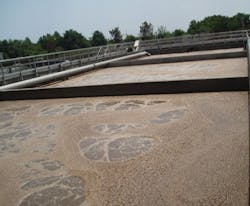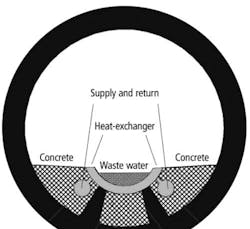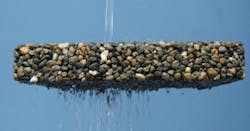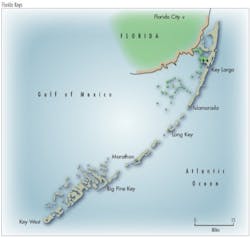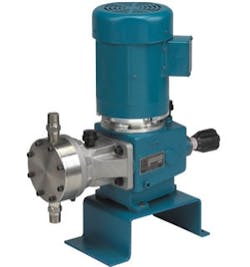How to Select the Most Reliable Pump for an Application
By Allan R. Budris, P.E.
The writer's past WaterWorld columns have covered individual hydraulic actions that can improve pump mean time between failures (MTBF). This column takes these actions a step further by showing how they can be combined to maximize overall pump reliability. The specific centrifugal pump hydraulic reliability factors covered are Pump Speed, Percent Best Efficiency Flow Rate, Net Positive Suction Head (NPSH) Margin, Suction Energy, and Impeller Material.
It is understood that many of these pump reliability improvement actions could be at the expense of increased initial cost. So the final purchase decision should look at how these reliability improvements will impact the total pump "Life Cycle Costs" (December 2009 Column), since the reduced cost of maintenance and down time, and possible improvements in pump efficiency could far exceed any increase in the initial pump cost. Who knows, if the MTBF is high enough, users could reduce the total initial cost by eliminating the requirement for a back up pump, as some "Best of Class" European pump users do.
PUMP SPEED (April 2008 Column)
Pump manufacturers design their pumps to operate at various speeds, with the maximum (limiting) speed typically based on bearing life, shaft stress, shaft deflection, casing strength, and/or NPSHR. By operating a pump at a slower then maximum speed, the user can see big improvements in bearing and mechanical seal life, plus reductions in cavitation and/or suction recirculation damage (through reduced NPSHR and Suction Energy). Figure 1 plots pump reliability vs. the ratio of the actual-to-maximum allowable pump speed, for two cases (actual field pump failures and laboratory pressure pulsation levels). So, by operating a pump at half its maximum rated speed (say 1,760 rpm vs. a maximum of 3,550 rpm) the relative reliability would be increased from .40 at the maximum speed to .78 at the reduced speed, or approximately twice the MTBF. This reduced speed to 1,760 rpm would also slightly increase the motor efficiency. This increased reliability from lower speeds should also be taken into account when looking to justify a variable speed drive.
PERCENT BEP FLOW RATE (December 2007 Column)
Where a pump operates on its "Head-Capacity" curve and how close the pump is to its best efficiency flow rate is both a pump selection and system issue, since a pump will always operate at the intersection between the pump H-Q and the system H-Q curves. Where the pump operates relative to the pump best efficiency flow rate has a large impact on pump reliability. Although, according to the field data, the best reliability is actually closer to 90%, then 100% of bep.
The reasons for the lower MTBF values at off bep flow rates are increasing pressure force variations around the impeller (higher radial bearing loads) at lower and higher flow rates; suction recirculation at lower flow rates, and more cavitation (higher NPSHR vs. lower NPSHA values) at higher flow rates. All of this can result in lower bearing, mechanical seal, wearing ring, and impeller life.
Typical reasons for pumps not operating near their bep flow rates are
- Including too much head and flow safety margin when selecting a pump.
- The actual system pressure drop is different than the initial calculated value.
- The system flow demand is different than the initial assumption.
- Changes to the system over time.
- Corrosion and wear of the pump and/or system.
Actual field testing (see Jan 2009 Column) is the best way to determine the true current system H-Q curve, which shows where the pump is actually operating relative to the pump bep flow rate. Once the actual system H-Q curve has been established, hardware changes to better match the pump and system can then be made, such as a new pump, new pump impeller (or impeller trim), or changes in the pump control method, such as the addition of a Variable Speed Drive.
NPSH MARGIN (January 2012 Column)
As discussed in last month's column, the amount of NPSH Margin provided to a pump, above the NPSHR (especially with High Suction Energy Pumps and/or pumps operating in the Suction Recirculation Region), can have a large impact on the reliability of the pump, as shown in figure 2. Typically you need a NPSH margin ratio of at least 4.0 (NPSHA/NPSHR), in the allowable operating range (above the start of suction recirculation), to eliminate all cavitation in a pump. This is why the maximum reliability, shown in figure 2, peaks at a NPSH margin of 4.0.
Figure 3 also shows this "NPSH Margin-Reliability" relationship, but for High Suction Energy pumps, where the suction pressure pulsations (which can have a direct impact on pump life) actually peak at NPSH Margin ratios in the range of 1.4 to 2.3 (depending on whether or not the pump is in suction recirculation). The reduction in pressure pulsations at NPSH Margin ratios below this peak value is caused by the increasing amounts of dissolved air that come out of solution at lower pressures (see June 2009 column).
SUCTION ENERGY (October 2007 Column)
Based on many years of experience, and actual field data, it has been found that the higher the pump Suction Energy, the lower the pump reliability, above a value of about 70 x 106. Suction Energy is the product of the pump speed (in RPM); impeller eye diameter (in inches); Suction Specific Speed (which is impacted by the impeller eye diameter); and the liquid specific gravity. But it is the pump type that determines the specific Suction Energy levels where vibration (High Suction Energy) and cavitation damage (Very High Suction Energy) starts in a pump (as shown in Table 1). As can be seen, the most sensitive pump type to elevated suction energy levels are pumps with little or no impeller vane overlap, such as two vaned impellers, while inducer pumps have the highest gating values.
SUCTION ENERGY/NPSH MARGIN COMBILED RELIABILITY
As mentioned above, there is a correlation between the Suction Energy of a pump and the NPSH Margin. Higher Suction Energy requires more NPSH Margin to suppress cavitation damage. The writer has combined these two factors into two reliability plots, comparing the ratio of the "Suction Energy Ratio" (pump Suction Energy divided by the High Suction Energy gating value for the pump type), with the "NPSH Margin Ratio" (NPSHA/NPSHR). Figure 4 is based on actual field MTBF reliability values, while figure 5 is based on Suction Pressure Pulsation levels.
IMPACT OF DIFFERENT IMPELLER MATERIALS ON PUMP LIFE
The final factor that can have a very large impact on the impeller cavitation damage component of pump life (experienced by High and Very High Suction energy pumps) is the material that the impeller is made of, as shown in Table 2. So changing from mild steel (reliability factor of 1.0) to stainless steel (reliability factor of 4.0), would increase the impeller life from cavitation damage by a factor of 4. Hard coatings, such as ceramic, can also increase impeller life.
COMBINING HYDRAULIC PUMP LIFE FACTORS
The net impact of all of the above individual reliability factors can be determined by combining their product to yield the "total relative reliability". This can be especially useful when comparing pump options for a specific application. Table 3 shows how the writer combined these hydraulic life factors for a problem pump installation at a major pump user. Four options were evaluated, with the relative reliability ranging from .29 for the current problem pump (which experienced a MTBF of about six months), to 2.00 for the best option (with a VFD). This means that the current six month life would be expected to increase to around 4 years, by selecting option #4.
CONCLUSIONS
So as spelled out above, this column provides the reliability conscious pump user with tools that can help select the most reliable pump for an application, and reduce overall life cycle pump costs.
About the Author: Allan R. Budris, P.E., is an independent consulting engineer who specializes in training, failure analysis, troubleshooting, reliability, efficiency audits and litigation support on pumps and pumping systems. With offices in Washington, NJ, he can be contacted via e-mail at [email protected].
More WaterWorld Current Issue Articles
More WaterWorld Archives Issue Articles


